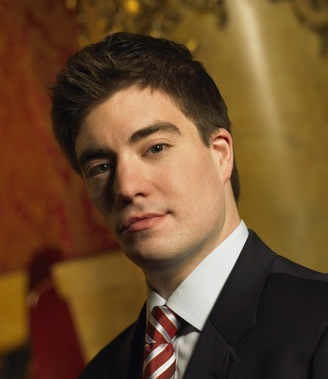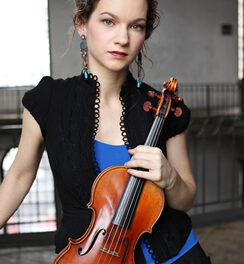Sitting in the sanctuary of the Chapel of the Cross with the warm sunlight streaming in the windows and hearing guests talking vivaciously prior to the Baroque and Beyond concert amplified the excitement I felt in anticipation of the opening concert Sunday afternoon of the North Carolina HIP (Historically-informed Performance) Music Festival under the umbrella of Mallarmé Chamber Players. Dr. Wylie S. Quinn, organist and choir master at the church, warmly welcomed this first concert of what one hopes becomes an annual festival. The group featured on Sunday, Baroque and Beyond, is sponsored by the Preservation Society of Chapel Hill and led by its artistic director, Beverly Biggs.
The five performers in this concert carried different roles in the music of the afternoon: Michael Maniaci, countertenor and featured guest, and Peter Lekx, baroque violin, operated in the realm of melody; the continuo accompaniment group, consisting of Stephie Vial, baroque cello, William Simms, alternating between theorbo and baroque guitar, and Beverly Biggs, harpsichord, skillfully and unobtrusively realized the figures in the scores and emphasized the bass line. The use of the theorbo added depth of sound to the ensemble.
Countertenor Michael Maniaci, with his gifted voice, opened the concert singing Antonio Vivaldi‘s aria, “Non ti Lusinghi la crudeltade” from Tito Manlio (RV 738). He has special tonal qualities to project a firm, powerful richness and possesses an unusually high range of notes well into those of a high soprano. He combined this endowment with a depth of musical expression, which convincingly conveyed the pain contained in this text. Mr. Lekx entered into the dialogue with expressive, energetic responses, and related with sensitivity to his colleagues, which included Mr. Simms playing theorbo. From where I was sitting, however, the violinist’s sound lacked parity with that of the singer, when the melodic parts were of equal weight.
Arcangelo Corelli’s La Folia, performed by Mr. Lekx from Corelli’s seldom-heard original score consisting of the theme and twenty-three variations, was at times an exciting tour de force for either the violin or cello. Mr. Lekx played in a sensitive, exuberant manner, often showing his deft skills in ornamentation. Balance issues emerged between the violinist and the accompaniment group, perhaps due to disproportionate sound from the latter.
Prior to intermission, the group performed a mid-seventeenth-century cantata for solo voice, “Lagrime mie,” composed by a woman (!!), Barbara Strozzi (1619-ca. 1664). Mr. Maniaci’s approach conveyed beautifully the depth of sadness and near despair found in the text. The use of the theorbo increased the richness of the musical experience.
Following intermission, Mr. Maniaci sang two major Bach arias having violin solos. The text of the first, “Erbarme dich” from the St. Matthew Passion, expresses tears from a weeping heart and eyes, which Mr. Maniaci conveyed with emotional intensity. Its rather slow tempo increased the impact on my heart. The second aria, “Laudamus te” from the Mass in B Minor, set in the key of A, was the first of Mr. Maniaci’s contributions to the program that was framed in a major key, which, after the previous texts of tears and sorrows, changed the affect in my psyche. The tempo, which at its break-neck speed showed well Mr. Maniaci’s virtuosity, became somewhat of a disadvantage for the violinist executing Bach’s very difficult writing for violin. I find the aria’s upbeat text of praise and glorification to be quite effective with a bit slower tempo as found in earlier historically-informed performances in the late twentieth century.
The quite charming work dating from the mid-1730s, Sonata No. 3 in D for cello by Andrea Caporale, an Italian cellist and composer, provided an apt vehicle for Ms. Vial to show her expressive style, careful phrasing, and facile technique that she played with grace. It was a delectable treat.
The program closed with Handel’s “Agitato da fiere tempeste” from Oreste. Its fiery energy, speed, and soprano coloratura singing by Mr. Maniaci and brilliant passage work by Mr. Lekx so energized the audience that they showed their appreciation for this piece and the prior ones with a vigorous and lengthy standing ovation. The players returned with an encore — Largo from Xerxes by Handel. The utter beauty of the singing and playing of this gem moved the listeners.
The programming included attractive literature representative of baroque pieces spanning the 100 years between the mid-1600s and the mid-1700s. This wonderful exposure to the breadth of baroque literature was not evident to the audience, for the concert program lacked composer’s dates, dates of pieces, and program notes. To emphasize the meaning of historically-informed performance, I would have really enjoyed having this information in front of me at the concert to place the literature in context, which perhaps might have included details about the theorbo, a less familiar early instrument, along with comments about how Baroque and Beyond integrates H.I.P. into their choices of literature, editions, and performance practices.
Overall, the concert was well done and we heard baroque masterpieces; issues noted above likely result from this being the first experience of a Festival. The 200 guests received the concert with animated enthusiasm.
The Festival idea is so fitting for the Chapel Hill/Durham area for the area has a long-standing love affair with early music. Besides Collegium Musicum performances at UNC and Duke, a group of local musicians – -Mary Frances Boyce, Eleanor Kinnaird, Jane Salemson, Jane Harris, and Florence Peacock — formed an early music group called I Musici di Cappella Collina way back in the early 1970s. They gave concerts regularly, and in the early 80s simplified their name to Music della Collina. They continued the concerts until 1987. In addition, early in the 1980s, Dr. Richard Luby and Brent Wissick, music faculty members at UNC, co-founded the department’s early music group, A Society for Performance on Original Instruments, whose name was changed later to Ensemble Courant. They presented concerts for about a decade between 1983 and 1993.
In recent years, new early music groups have entered the musical scene, such as Aliénor, and Baroque and Beyond. And I should mention the recent local performance of Beethoven’s Ninth Symphony by Sir John Eliot Gardiner. Now, the North Carolina HIP Music Festival is emerging. For this year and future years, I say . . . HIP, HIP, HOORAY! For more information about the Festival schedule please see our calendar, and this preview.












